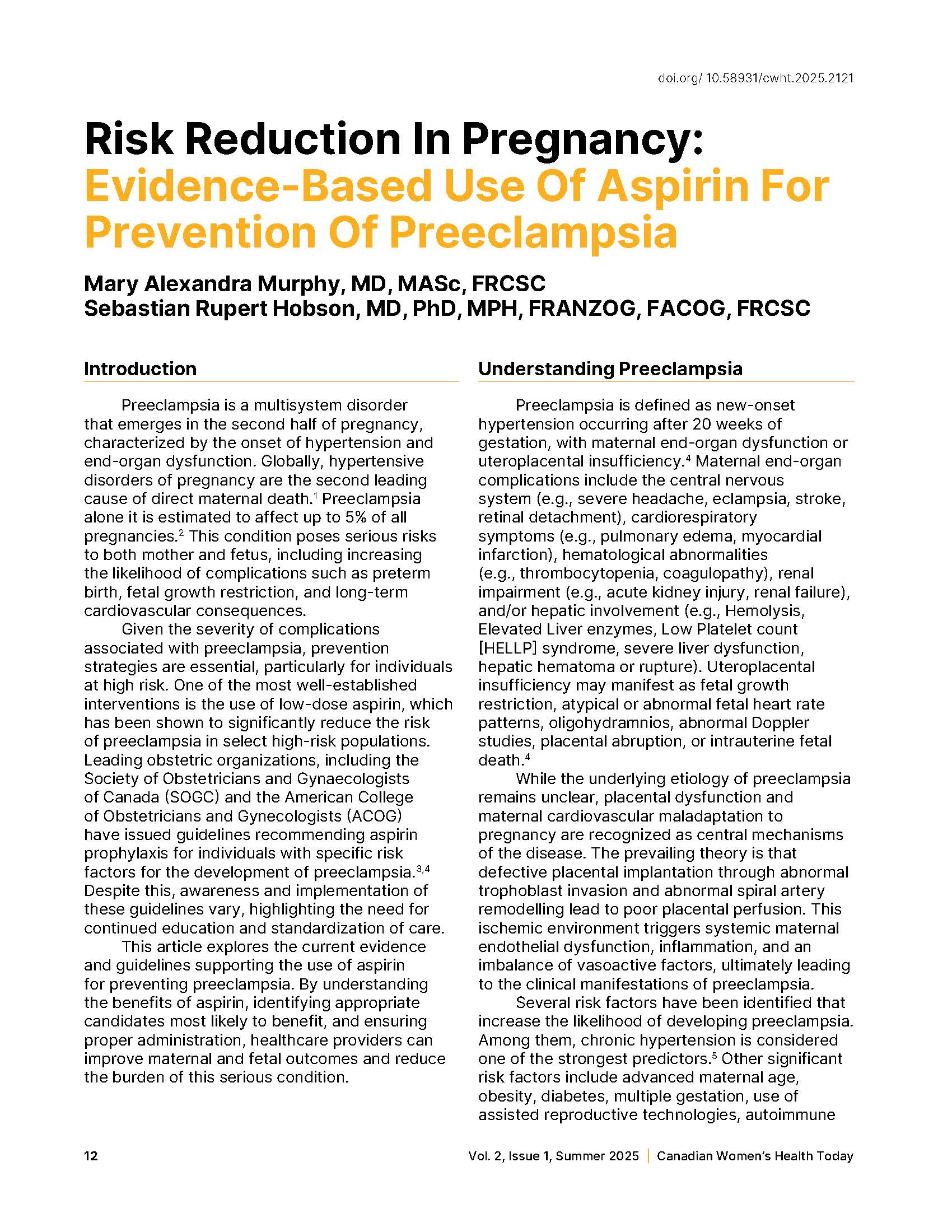Risk Reduction In Pregnancy: Evidence-Based Use Of Aspirin For Prevention Of Preeclampsia
DOI:
https://doi.org/10.58931/cwht.2025.2121Abstract
Preeclampsia is a multisystem disorder that emerges in the second half of pregnancy, characterized by the onset of hypertension and end-organ dysfunction. Globally, hypertensive disorders of pregnancy are the second leading cause of direct maternal death.1 Preeclampsia alone it is estimated to affect up to 5% of all pregnancies. This condition poses serious risks to both mother and fetus, including increasing the likelihood of complications such as preterm birth, fetal growth restriction, and long-term cardiovascular consequences.
Given the severity of complications associated with preeclampsia, prevention strategies are essential, particularly for individuals at high risk. One of the most well-established interventions is the use of low-dose aspirin, which has been shown to significantly reduce the risk of preeclampsia in select high-risk populations. Leading obstetric organizations, including the Society of Obstetricians and Gynaecologists of Canada (SOGC) and the American College of Obstetricians and Gynecologists (ACOG) have issued guidelines recommending aspirin prophylaxis for individuals with specific risk factors for the development of preeclampsia. Despite this, awareness and implementation of these guidelines vary, highlighting the need for continued education and standardization of care.
This article explores the current evidence and guidelines supporting the use of aspirin for preventing preeclampsia. By understanding the benefits of aspirin, identifying appropriate candidates most likely to benefit, and ensuring proper administration, healthcare providers can improve maternal and fetal outcomes and reduce the burden of this serious condition.
References
Say L, Chou D, Gemmill A, Tuncalp O, Moller AB, Daniels J, et al. Global causes of maternal death: a WHO systematic analysis. Lancet Glob Health. 2014;2(6):e323–333. doi:10.1016/S2214-109X(14)70227-X
Abalos E, Cuesta C, Grosso AL, Chou D, Say L. Global and regional estimates of preeclampsia and eclampsia: a systematic review. Eur J Obstet Gynecol Reprod Biol. 2013;170(1):1–7. doi:10.1016/j.ejogrb.2013.05.005
Bryant AS, Cahill AG, Kuller JA, Louis JM, Turrentine M, the American College of Obstetricians and Gynecologists and the Society for Maternal-Fetal Medicine. Low-Dose Aspirin Use for the Prevention of Preeclampsia and Related Morbidity and Mortality [Internet]. 2021 [cited 2025 Jul 17]. Available from: https://www.acog.org/clinical/clinical-guidance/practice-advisory/articles/2021/12/low-dose-aspirin-use-for-the-prevention-of-preeclampsia-and-related-morbidity-and-mortality.
Magee LA, Smith GN, Bloch C, Cote AM, Jain V, Nerenberg K, et al. Guideline No. 426: Hypertensive Disorders of Pregnancy: Diagnosis, Prediction, Prevention, and Management. J Obstet Gynaecol Can. 2022;44(5):547–571 e541. doi:10.1016/j.jogc.2022.03.002
Wright D, Syngelaki A, Akolekar R, Poon LC, Nicolaides KH. Competing risks model in screening for preeclampsia by maternal characteristics and medical history. Am J Obstet Gynecol. 2015;213(1):62.e61–62.e10. doi:https://doi.org/10.1016/j.ajog.2015.02.018
Lisonkova S, Joseph K. Incidence of preeclampsia: risk factors and outcomes associated with early-versus late-onset disease. Am J Obstet Gynecol. 2013;209(6):544.e1-544.e12. doi:10.1016/j.ajog.2013.08.019
Pittara T, Vyrides A, Lamnisos D, Giannakou K. Pre-eclampsia and long-term health outcomes for mother and infant: an umbrella review. BJOG. 2021;128(9):1421–1430. doi:10.1111/1471-0528.16683
Davis EF, Lazdam M, Lewandowski AJ, Worton SA, Kelly B, Kenworthy Y, et al. Cardiovascular risk factors in children and young adults born to preeclamptic pregnancies: a systematic review. Pediatrics. 2012;129(6):e1552–e1561. doi:10.1542/peds.2011-3093
Crandon AJ, Isherwood DM. Effect of aspirin on incidence of pre-eclampsia. Lancet. 1979;1(8130):1356. doi:10.1016/s0140-6736(79)91996-2
Dimitriadis E, Rolnik DL, Zhou W, Estrada-Gutierrez G, Koga K, Francisco RPV, et al. Pre-eclampsia. [published correction appears in Nat Rev Dis Primers. 2023 Jul 3;9(1):35. doi: 10.1038/s41572-023-00451-4.]. Nat Rev Dis Primers. 2023;9(1):8. Published 2023 Feb 16. doi:10.1038/s41572-023-00417-6
Rolnik DL, Wright D, Poon LC, O'Gorman N, Syngelaki A, de Paco Matallana C, et al. Aspirin versus placebo in pregnancies at high risk for preterm preeclampsia. N Engl J Med. 2017;377(7):613–622. doi:10.1056/NEJMoa1704559
US Preventive Services Task Force, Davidson KW, Barry MJ, Mangione CM, Cabana M, Caughey AB, et al. Aspirin use to prevent preeclampsia and related morbidity and mortality: US Preventive Services Task Force recommendation statement. JAMA. 2021;326(12):1186–1191. doi:10.1001/jama.2021.14781
Bujold E, Roberge S, Lacasse Y, Bureau M, Audibert F, Marcoux S, et al. Prevention of preeclampsia and intrauterine growth restriction with aspirin started in early pregnancy: a meta-analysis. Obstet Gynecol. 2010;116(2 Pt 1):402–414. doi:10.1097/AOG.0b013e3181e9322a
Webster K, Fishburn S, Maresh M, Findlay SC, Chappell LC, Guideline Committee. Diagnosis and management of hypertension in pregnancy: summary of updated NICE guidance. BMJ. 2019;366:l5119. doi:10.1136/bmj.l5119
Kupka E, Hesselman S, Gunnarsdóttir J, Wikström A-K, Cluver C, Tong S, et al. Prophylactic aspirin dose and preeclampsia. JAMA Netw Open. 2025;8(2):e2457828. doi:10.1001/jamanetworkopen.2024.57828
Duley L, Meher S, Hunter KE, Seidler AL, Askie LM. Antiplatelet agents for preventing pre-eclampsia and its complications. Cochrane Database Syst Rev. 2019;2019(10):CD004659. doi:10.1002/14651858.CD004659.pub3

